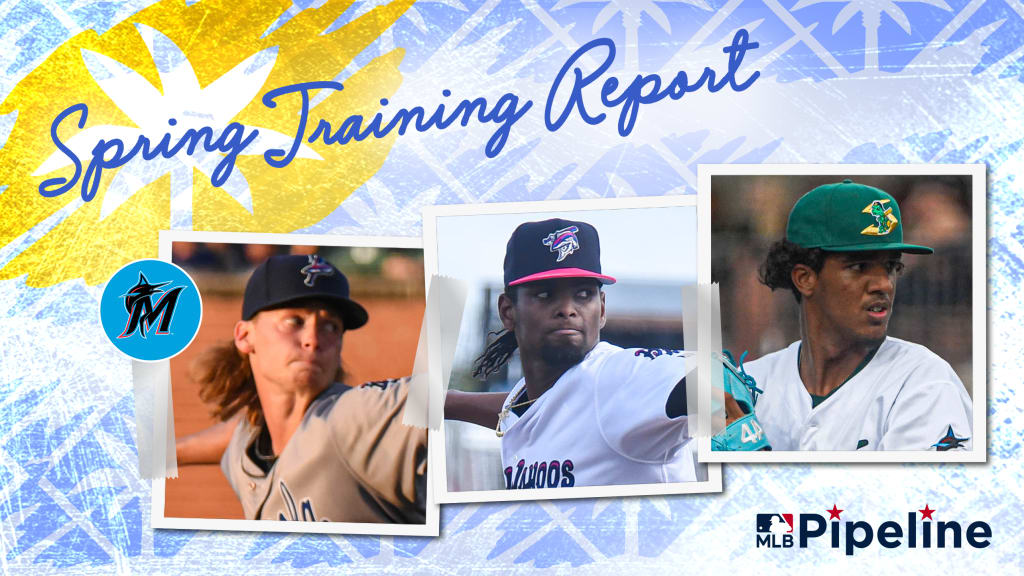
JUPITER, Fla. -- Sixto Sánchez isn’t throwing.
That’s a worrisome set of four words involving any prospect. Especially when it’s a Top 100 prospect. Double especially when it’s a Top 100 prospect who once drew comparisons to Pedro Martinez but didn’t pitch at all in games the previous season due to surgery on the same right shoulder that’s giving him issues now.
In most camps, it would be cause for panic. And in Marlins camp, just as it would be anywhere, it’s of course worrisome to have a promising young star sidelined. But it’s also a cause to turn to the organization’s considerable pitching depth.
“I think that’s the signature of what’s been built here,” said Miami field coordinator Patrick Osborn. “This is going to be a pitching-first org. We’re showing that. We’re not just saying it. We have a lot of high-end starting pitchers that the industry is aware of. What makes this a desirable place within the industry is that, hey, you look at the Marlins and they’re rolling 10 deep in terms of average to above-average starting pitching. We’re fortunate. It’s not every day you see an organization built this way.”
There are special Draft picks, like 2020 third overall selection Max Meyer and 2020 second-rounder Dax Fulton, who remain Top 10 prospects in the system. There are international signees like Edward Cabrera and Eury Perez, whose bonuses combined for $300,000 but are now both comfortably Top 100 prospects. There are player-development success stories, like Jake Eder’s rise from the 2020 fourth round to the No. 10 slot in MLB Pipeline’s Top 10 LHP prospects, despite his Tommy John surgery. There are Major League-experienced types in Nick Neidert, Braxton Garrett and Cody Poteet.
Can depth alone help the Marlins weather the extended loss of a once-potential ace? Not entirely. But it’s through that depth that a prospect like Perez, who hadn’t seen the Minors at all before 2021 and finished with a 1.96 ERA across 20 A-ball starts, can rise and command attention. Building depth through player acquisition and internal development adds lottery tickets. The more depth, the better the odds one of them will hit.
It’s something the Major League team has certainly taken to heart. If the season started today, Jesús Luzardo would be likely the only member of the Miami rotation who didn’t spend significant time in the Marlins' Minor League system. Even club ace Sandy Alcántara, who was acquired from the Cardinals in the December 2017 trade for Marcell Ozuna, was still a prospect when he first joined the organization.
The Fish plan to exhibit their confidence in their Minor League starting pitching corps by riding them hard right from the off. After around 30 pitchers reported to early Minor League workouts in January, some are already built up to 75 pitches in their spring progressions and could be prepared to go five innings or so come Opening Day on April 8.
The thought there is to let starters lighten the load on bullpens early and carry Miami affiliates from the first pitch. In other words, let a strength be a strength, even if it doesn’t involve Sánchez.
“I think we're really well-positioned to get these guys out of the gate,” said director of Minor League operations Hector Crespo. “Those that we started in January this year, the way they've kind of carried on and how they're progressing right now, it's been really encouraging. I think it's primed to be a big year for multiple of those guys.”
Camp standout: Kahlil Watson
A ton of eyes were going to be on the 2021 16th overall pick coming into his first spring. The North Carolina shortstop flashed five above-average tools in high school, including 65-grade speed, and even though it felt like he fell to Miami in the middle of the first round, he still managed an above-slot $4,540,790 bonus -- a club record for a prep player.
The left-handed slugger has backed up that investment in his first Spring Training.
Watson showed an incredibly quick bat in his early looks in Jupiter and hasn’t let the grind of professional life get in the way of putting on constant shows in all facets of the game to this point. Miami’s top prospect seems set to open at Single-A Jupiter, where it wouldn’t be a surprise to see him ahead of the league already, based on the way his tools have translated against his Marlins peers to this point.
“I think he's one of the more polished 18-year-old offensive players that I've been around since I've been here,” Crespo said. “His feel in the box. His competitive ABs. He recognizes spin. He impacts the ball. He is a really polished young hitter, and he's been standing out big time. Obviously, we have young prospects now, but he's kind of staying at the cream of the crop there at the top, so I'm really excited with where he's at.”
“I could watch him hit all day long,” said Osborn.
Something to prove: JJ Bleday
Is Bleday’s prospect stock over after a difficult 2021 regular season? Not by a long shot. Is it different now than it was a year ago? Well, sure.
The 2019 fourth overall pick, who led NCAA Division I with 27 homers in his final spring at Vanderbilt, lost what would have been his first full season in 2020 and was moved to Double-A Pensacola for all of last year. The numbers were tough -- a .212/.323/.373 line with 12 homers and a 97 wRC+ over 110 games.
The 24-year-old outfielder said he felt himself pressing early on to be more of a home run hitter and had to re-find an approach that allowed him to stay inside fastballs again. That, along with increased strength following a change in his training regimen, helped Bleday take off again in the Arizona Fall League, where he was co-Hitter of the Year after producing a .316/.435/.600 line with five homers in 24 games.
Now on the Major League side of Spring Training as a non-roster invite, the former Commodore has an opportunity to prove that he learned from 2021 and has moved past his struggles. There’s still the potential to be an above-average hitter from the left side with good defensive skills anywhere in the outfield.
“Swing adjustments, mental adjustments, getting into a place of comfort and where he trusted what he was doing,” Osborn said, “that was the first step in terms of how this kid's going to take off.”
Prospect we’ll be talking about in 2023: Jose Salas
The Marlins might have a shortstop logjam at Single-A Jupiter this summer in the best way possible. Joining Watson at that level could well be another 18-year-old in Salas, who played 27 games for the Hammerheads in 2021.
Signed for $2.8 million in July 2019, the switch-hitter earns the twitchy scouting tag with his swing from both sides and has the quick feet to match. He’s already added strength and could be an average power hitter in time, notable for a shortstop. As is the case with Watson and another teenage infielder Ian Lewis, the Marlins are giving Salas looks at second base and third in case all three need to share the dirt in Jupiter. Offensively at least, the potential is there for Salas to break out in his first potential Minor League season of 100-plus games.
“There are baseball instincts in terms of the mental part of the game,” Osborn said. “There's natural strength. It's a short, quick swing where he doesn't have to try to artificially generate power because of the natural strength. Defensively, all the actions are there -- the ability to throw from different arm slots, a very good game clock. For an 18-year-old kid, he's advanced in really every area.”


